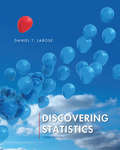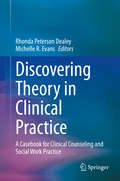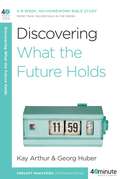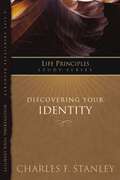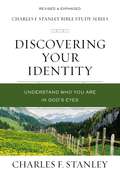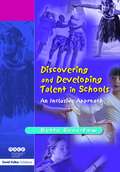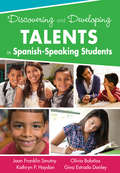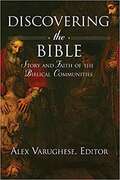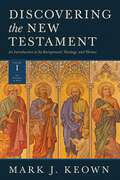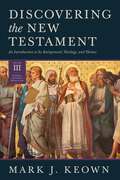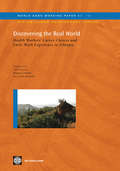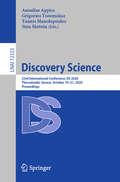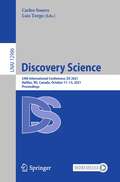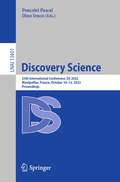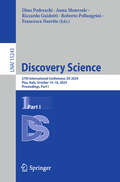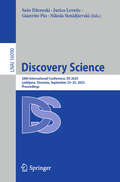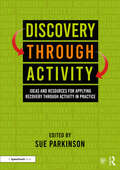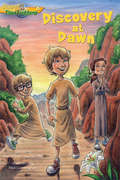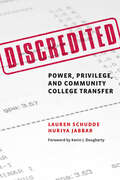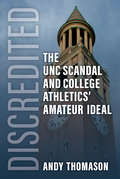- Table View
- List View
Discovering Statistics
by Daniel T. LaroseDan Larose's Discovering Statistics is the ideal text for instructors who want to teach the basics of statistical computation as well as how to interpret and apply the results of those computations. Using real data, contemporary examples, step-by-step solutions, extensive pedagogy, and support for common statistical software options, the text familiarizes students with essential computational skills, while helping them build the conceptual understanding needed to interpret and explain their findings. As a result, Discovering Statistics helps students develop a solid and lasting "statistical sense" that will prove valuable throughout their academic and professional careers.
Discovering Theory in Clinical Practice: A Casebook for Clinical Counseling and Social Work Practice
by Rhonda Peterson Dealey Michelle R. EvansThis theory-focused casebook provides the reader with an overview of multiple counseling theories and utilizes specific cases representing a variety of clients to demonstrate the integration of theory in clinical counseling and social work practice. Through the use of dynamic cases, the reader is shown how theory informs day-to-day practice. Each theoretical case study includes a section on cultural considerations and discussion questions:Object Relations Theory: The Case of ElyseSelf Psychology Theory: The Case of EvanPerson-Centered Therapy: The Case of TommySolution-Focused Brief Therapy: The Case of JimRelational Cultural Theory: The Case of MonicaSystems Theory: The Case of EsperanzaExperiential Therapy: The Case of SamDiscovering Theory in Clinical Practice: A Casebook for Clinical Counseling and Social Work Practice is an essential text for instructors to teach the development of a theoretical foundation that easily integrates into core topics of relevance for graduate students in social work, counseling, psychology, marriage and family therapy, and human behavior who intend to work with a diverse set of client populations. The book also will be a great asset to early-career practitioners and clinical supervision participants who are continuing to build a professional working template of skills in both theory and practice as they conceptualize patient problems and develop treatment plans.
Discovering What the Future Holds: A 6-Week, No-Homework Bible Study (40-Minute Bible Studies)
by Kay Arthur Georg HuberWhy wonder or worry about the future? God has given you a sneak preview. With all that’s transpiring in the world, people can’t help but wonder what the future holds. Will there ever be peace on earth? How long will the world live under the threat of terrorism? Is a one-world ruler on the horizon? God has already provided answers to these questions in the book of Daniel, which sets forth His blueprints for the future. In fact, when you understand the prophecies Daniel reveals, every other prophecy in the Bible will fit somewhere in the plan. If you want to understand the future, if you want to know what will happen in the “end of days,” you need to begin with the prophecies of the Book of Daniel. Join me on this glorious adventure into the future. --Kay Arthur The 40-Minute Bible Studies tackle vital issues in short, easy-to-grasp lessons for personal or group use–with no homework required.
Discovering Your Career
by Ann K. Jordan Lynne T. WhaleyIn a unique approach to career planning, Discovering Your Career matches a career area to the student rather than the student to a career area. This approach focuses on each student's needs and guides the student to pursuing a career based on individual talents and passions. Discovering Your Career addresses current career trends related to technology, workforce diversity, and global markets; explores investigating careers via job shadowing, service learning, and community mentoring; explains and discusses a variety of career and educational options; and emphasizes self-awareness, goal setting, decision making, reduction of prejudice, SCANS competencies, and economic responsibility. Discovering Your Career also promotes future career success by providing students with current and projected career information and by helping them build skills in such vital areas as networking, teamwork, communication, and problem solving.
Discovering Your Identity (Life Principles Study Series)
by Charles F. Stanley"Who are you?" When someone asks that question, how do you respond?Do you give your name, then describe what you do for a living? Most people answer this question with basic, superfivial information about their lives, but most Christians don't really know the truth about who they are.You are a saint! If you have accepted Jesus Christ as your Lord and Savior, then this is the correct answer. And the term saint carries many layers of meaning, all of which is great news. The only right way to understand who we are is to see ourselves from God's perspective, as described in His Word.This book will lead you through the many layers of understanding who you are in the eyes of God. You are a beloved child of God; you are the heir of God's inheritance; you are a member of the Body of Christ. In short, you are God's Masterpiece!Features Include:Features teachings from one of America's best-loved pastors and theologiansTopical studies filled with life application principlesFor individual study or to be shared with a small group
Discovering Your Identity: Understand Who You Are in God's Eyes (Charles F. Stanley Bible Study Series)
by Charles F. StanleyFind out who you are in Christ.Who are you? The only right way to understand who you are is to see yourself from God's perspective, as described in His Word.In Discovering Your Identity, you will be led through the many layers of understanding who you are in the eyes of God. As your search God's Word, you will discover many truths about yourself—such as the fact you are a beloved child of God, you are the heir of God's inheritance, and you are a member of the Body of Christ. In short . . . you are God's masterpiece!With over 1 million copies sold, the Charles F. Stanley Bible Study Series is a unique approach to Bible study, incorporating biblical truth, personal insights, emotional responses, and a call to action.Each study draws on Dr. Stanley's many years of teaching the guiding principles found in God's Word, showing how we can apply them in practical ways to every situation we face. This edition of the series has been completely revised and updated, and includes two brand-new lessons from Dr. Stanley.Each of the twelve lessons includes:Overview: A brief look at what is covered in the lessonLife's Questions: A teaching from Dr. Stanley that unpacks the topic of the lessonLiving the Principle: Application and Bible study questions based on the key pointsReflection: Key takeaways to put into practice today and tomorrow
Discovering Your Spiritual Gifts
by Luci Swindoll Phyllis BennettThe Women of Faith Bible Study Series helps you turn the laughter and lessons of Women of Faith conferences into a journey of growth shared by special friends. Whether or not you've attended a conference, you will appreciate the bonds that form as you join with other women linked together in friendship, prayer, joy, and faith. Each study will also lead you to a deeper love of the Bible and a greater appreciation of the power of God's Word. Each session includes six sections: A Moment for Quiet Reflection . . . Just for Fun - Knowing God's Heart . . . Praying Together - Friendship Boosters . . . Making it Real in Your Own Life - The leader's guide that's included makes it easy to facilitate weekly Bible studies that will nurture your knowledge of Scripture and your sense of God's presence in your life. Six Sessions Include -- Gifts Tagged "Uniquely You!" - Opening the Gifts - Part 1 Opening the Gifts - Part 2 Gifts for the Family - Pleasing the Gift-Giver - Unopened Gifts
Discovering and Developing Talent in Schools: An Inclusive Approach
by Bette Gray-FowHow can primary and secondary schools best identify and provide for pupils with talents in the creative arts and sport? This book contains a range of practical and inclusive strategies to help schools enable and encourage pupils to make the most of their talents, including: -a fresh look at definitions of talent -advice on identifying talented pupils in primary and secondary schools -information on the unique needs and characteristics of talented pupils -guidance on the role of both in-school and out-of-school provision -a whole-school audit, to assess provision in the talent area -advice on developing whole-school and departmental policies for talented pupils Aimed at gifted and talented coordinators, teachers and school managers, this book will also benefit leaders of extra-curricular activities, and parents.
Discovering and Developing Talents in Spanish-Speaking Students
by Joan F. Smutny Kathryn P. Haydon Olivia G. Bolanos Gina M. Danley¡Atención! Recognize the strengths of Spanish-speaking students! How do you nurture the gifts and talents of the growing population of Hispanic students? This book provides teachers and leaders with the skills needed to uncover each child’s abilities and ultimately boost achievement for gifted Spanish-speaking students. Packed with strategies that teachers can use immediately to enhance instruction and assessment, this book shows how to: Recognize students’ unique strengths Identify and develop the gifts of bilingualism and different cultures Create challenging learning experiences for every student in the class Adapt tools and strategies to meet each learner’s unique needs Connect with parents and the greater Spanish-speaking community
Discovering the Bible: Story and Faith of the Biblical Communities
by Alex VarugheseDiscovering the Bible has everything you're looking for in a survey of the Bible. It examines the Bible's amazing message and story of faith in a way that will captivate readers and impel them to learn more. Thorough, sound biblical scholarship combined with an eye-catching format and easy-to-understand writing style make this textbook a must-have for every Christian's library.In Discovering the Bible, you'll find:Objectives defined for each lessonPersonal questions to help you relate the Bible to your lifeSidebars to explain theological pointsKeywords identified and defined on each pageStudy questions for review of the materialSummary statements at the end of each chapterListing of resources for further study at the end of each chapterColorful pages and images that make it attractive to readShort, well-organized chapters
Discovering the Culture of Childhood
by Carol Garhart Mooney Emily PlankView the culture of childhood through a whole new lens. Identify age-based bias and expand your outlook on and understanding of early childhood as a culture. Examine various elements of childhood culture: language, belief economics, arts, and social structure to understand children's dispositions of questioning, engagement, and cooperation.Emily Plank specializes in play-based education, diversity and culture in early childhood education, and outdoor learning. In 2011, the Iowa Association for the Education of Young Children identified Emily as one of seven emerging leaders. She earned her bachelor's degree from Pepperdine University. She and her family currently reside in Lausanne, Switzerland.
Discovering the New Testament: An Introduction to Its Background, Theology, and Themes (Volume I: The Gospels and Acts)
by Mark J. KeownDiscovering the New Testament is a new and comprehensive introduction to the New Testament in three volumes, reflecting current research and scholarship in New Testament studies. Each volume provides a thorough discussion of background issues as well as treating theological themes and practical application. The first volume on the Gospels and Acts covers Jewish and Greco--Roman backgrounds, critical methodologies, the synoptic problem, and surveys each of the four gospels and Acts. It concludes with three chapters that explore the key theme of the kingdom of God, including its Old Testament background, the place of miracles, and an examination of Jesus' parables. Ideal for college or seminary students, the volumes provide numerous maps and charts, as well as discussion questions for each chapter and a focus on real--life relevance and application. Forthcoming volumes will focus on Paul (Vol. 2) and the general epistles and Revelation (Vol. 3).
Discovering the New Testament: An Introduction to Its Background, Theology, and Themes (Volume III: General Letters and Revelation)
by Mark J. KeownDiscovering the New Testament is a new and comprehensive introduction to the New Testament in three volumes, reflecting current research and scholarship in New Testament studies. Each volume provides a thorough discussion of background issues as well as treating theological themes and practical application. In this third volume, Mark J. Keown surveys Hebrews, the General Epistles, and Revelation. In addition to covering introductory matters, Keown addresses key concerns for each book, such as the use of the Old Testament in Hebrews, James's view of justification, the relationship of 2 Peter and Jude, and Revelation's various interpretative approaches. Ideal for college or seminary students, Discovering the New Testament provides numerous maps and charts as well as discussion questions for each chapter and a focus on real--life relevance and application.
Discovering the Real World: Health Workers' Career Choices and Early Work Experience in Ethiopia
by Magnus Lindelow Pieter Serneels Jose Garcia Montalvo Danila SerraThis paper presents unique evidence on health workers' career choices in Ethiopia. It shows that challenges like health workers' limited willingness to work in rural areas, as well as their likelihood to migrate abroad vary substantially and are correlated with background, motivation, and job satisfaction. Governments in Africa have identified human resources for health as a priority to improve health outcomes. This study is a valuable resource to better understand health worker choices and help toward the design of more effective human resource policies. This working paper was produced as part of the World Bank's Africa Region Health Systems for Outcomes (HSO) Program. The Program, funded by the World Bank, the Government of Norway, the Government of the United Kingdom and the Global Alliance for Vaccines and Immunization (GAVI), focuses on strengthening health systems in Africa to reach the poor and achieve tangible results related to Health, Nutrition and Population. The main pillars and focus of the program center on knowledge and capacity building related to Human Resources for Health, Health Financing, Pharmaceuticals, Governance and Service Delivery, and Infrastructure and ICT.
Discovery Science: 23rd International Conference, DS 2020, Thessaloniki, Greece, October 19–21, 2020, Proceedings (Lecture Notes in Computer Science #12323)
by Yannis Manolopoulos Annalisa Appice Stan Matwin Grigorios TsoumakasThis book constitutes the proceedings of the 23rd International Conference on Discovery Science, DS 2020, which took place during October 19-21, 2020. The conference was planned to take place in Thessaloniki, Greece, but had to change to an online format due to the COVID-19 pandemic. The 26 full and 19 short papers presented in this volume were carefully reviewed and selected from 76 submissions. The contributions were organized in topical sections named: classification; clustering; data and knowledge representation; data streams; distributed processing; ensembles; explainable and interpretable machine learning; graph and network mining; multi-target models; neural networks and deep learning; and spatial, temporal and spatiotemporal data.
Discovery Science: 24th International Conference, DS 2021, Halifax, NS, Canada, October 11–13, 2021, Proceedings (Lecture Notes in Computer Science #12986)
by Carlos Soares Luis TorgoThis book constitutes the proceedings of the 24th International Conference on Discovery Science, DS 2021, which took place virtually during October 11-13, 2021.The 36 papers presented in this volume were carefully reviewed and selected from 76 submissions. The contributions were organized in topical sections named: applications; classification; data streams; graph and network mining; machine learning for COVID-19; neural networks and deep learning; preferences and recommender systems; representation learning and feature selection; responsible artificial intelligence; and spatial, temporal and spatiotemporal data.
Discovery Science: 25th International Conference, DS 2022, Montpellier, France, October 10–12, 2022, Proceedings (Lecture Notes in Computer Science #13601)
by Poncelet Pascal Dino IencoThis book constitutes the proceedings of the 25th International Conference on Discovery Science, DS 2022, which took place virtually during October 10-12, 2022. The 27 full papers and 12 short papers presented in this volume were carefully reviewed and selected from 59 submissions.
Discovery Science: 26th International Conference, DS 2023, Porto, Portugal, October 9–11, 2023, Proceedings (Lecture Notes in Computer Science #14276)
by João Gama Albert Bifet Rita P. Ribeiro Ana Carolina Lorena Pedro H. AbreuThis book constitutes the proceedings of the 26th International Conference on Discovery Science, DS 2023, which took place in Porto, Portugal, in October 2023. The 37 full papers and 10 short papers presented in this volume were carefully reviewed and selected from 133 submissions. They were organized in topical sections as follows: Machine learning methods and applications; natural language processing and social media analysis; interpretability and explainability in AI; data analysis and optimization; fairness, privacy and security in AI; control and spatio-temporal modeling; graph theory and network analysis; time series and forecasting; healthcare and biological data analysis; anomaly, outlier and novelty detection.
Discovery Science: 27th International Conference, DS 2024, Pisa, Italy, October 14–16, 2024, Proceedings, Part I (Lecture Notes in Computer Science #15243)
by Dino Pedreschi Riccardo Guidotti Anna Monreale Roberto Pellungrini Francesca NarettoThe two-volume set LNAI 15243 + 15244 constitutes the proceedings of the 27th International Conference on Discovery Science, DS 2024, which took place in Pisa, Italy, during October 14-16, 2024. The 53 full papers presented in the proceedings were carefully reviewed and selected from 121 submissions. They were organized in topical sections as follows: Part I: LLM, Text Analytics, and Ethical Aspects of AI; Natural Language Processing, Sequential Data and Science Discovery; Data-Driven Science Discovery Methodologies; Graph Neural Network, Graph Theory, Unsupervised Learning and Regression; Part II: Tree-Based Models and Causal Discovery; Security and Anomaly Detection; Computer Vision and Explainable AI; Classification Models; SoBigData++: City for Citizens and Explainable AI; SoBigData++: Societal Debates and Misinformation Analysis.
Discovery Science: 27th International Conference, DS 2024, Pisa, Italy, October 14–16, 2024, Proceedings, Part II (Lecture Notes in Computer Science #15244)
by Dino Pedreschi Riccardo Guidotti Anna Monreale Roberto Pellungrini Francesca NarettoThe two-volume set LNAI 15243 + 15244 constitutes the proceedings of the 27th International Conference on Discovery Science, DS 2024, which took place in Pisa, Italy, during October 14-16, 2024. The 53 full papers presented in the proceedings were carefully reviewed and selected from 121 submissions. They were organized in topical sections as follows: Part I: LLM, Text Analytics, and Ethical Aspects of AI; Natural Language Processing, Sequential Data and Science Discovery; Data-Driven Science Discovery Methodologies; Graph Neural Network, Graph Theory, Unsupervised Learning and Regression; Part II: Tree-Based Models and Causal Discovery; Security and Anomaly Detection; Computer Vision and Explainable AI; Classification Models; SoBigData++: City for Citizens and Explainable AI; SoBigData++: Societal Debates and Misinformation Analysis.
Discovery Science: 28th International Conference, DS 2025, Ljubljana, Slovenia, September 23–25, 2025, Proceedings (Lecture Notes in Computer Science #16090)
by Sašo Džeroski Jurica Levatić Gianvito Pio Nikola SimidjievskiThe DS 2025 constitutes the proceedings of the 28th International Conference on Discovery Science, DS 2025, which took place in Ljubljana, Slovenia, during September 22–26, 2025. The 38 full papers presented in this volume were carefully reviewed and selected from 86 submissions. They were organized in topical sections as follows: the development and analysis of methods for discovering scientific knowledge, coming from machine learning, data mining, and intelligent data analysis, and big data analytics, as well as their application in various domains.
Discovery Through Activity: Ideas and Resources for Applying Recovery Through Activity in Practice
by Sue ParkinsonDiscovery Through Activity provides a compendium of ideas, resources and practice evaluations that will inspire practitioners to be even more imaginative and to customise their own Recovery Through Activity programmes to meet the specifi c needs of participants. The original Recovery Through Activity handbook offers a flexible programme that is widely used in adult mental health settings. This accompanying and complementary resource shows how the intervention has been extended, adapted and applied service-wide. The resource showcases the work of a growing community of practitioners who have successfully facilitated Recovery Through Activity programmes to provide a forum for people to refl ect on their occupational lives and discuss and practise lifestyle choices that will enable them to improve their health and wellbeing. It includes: • an extended range of flexible ideas and resources to meet the needs of participants in Recovery Through Activity sessions • examples of how to apply Recovery Through Activity in one- to- one sessions and virtual groups • encouragement to adopt Recovery Through Activity across your services with confidence. With contributions illustrating the effective application of Recovery Through Activity in a range of settings and situations, this is a valuable resource for occupational therapists and other practitioners in mental health settings.
Discovery at Dawn (Gospel Time Trekkers #6)
by Maria Grace Dateno FSP Paul CunninghamIn this sixth volume of the Gospel Time Trekkers series, children ages 6-8 are taken on a journey that imaginatively retraces the events surrounding Jesus's crucifixion and resurrection, revealing the ultimate meaning of giving up something for others.
Discredited: Power, Privilege, and Community College Transfer
by Lauren Schudde Huriya JabbarAn incisive investigation of the often fraught student-transfer pathways from community colleges to four-year institutions—and a blueprint for process reform
Discredited: The UNC Scandal and College Athletics' Amateur Ideal
by Andy ThomasonIn 2009, the University of North Carolina at Chapel Hill was on top of the world. Consistently named one of the top universities in the country, it had welcomed a new phenom of a chancellor who promised to lead the public Ivy into the future. In the all-important athletic realm, the Tar Heels were the Coca-Cola of athletic brands. Resting upon the legacy of legendary basketball coach Dean Smith, UNC had carved out a reputation of excellence paired with squeaky-clean adherence to the rules. Supporters had a name for that irresistible ethos: the Carolina Way. The Tar Heels were climbing even higher. That year, they won their fifth national championship in men's basketball and looked poised to climb the ranks in football under a new, high-powered coach. But within just a few years, it all came crashing down. The Tar Heels' success, it turned out, was based on a foundation of deceit. Athletes were flocking to a slate of fake classes that advisers deftly used to keep them eligible to play. That revelation and others metastasized into one of the most damaging scandals ever to visit an American college. In Discredited, journalist Andy Thomason provides a gripping and authoritative retelling of the scandal through the eyes of four of its key participants: the secretary who presided over the fake classes, the professor who directed players toward them, the literacy specialist turned whistleblower who sought to expose the system, and the chancellor who found his career suddenly on the line. The heart-stopping narrative reveals the toll of a college's investment in major sports, and the amateurism myth upon which it is based. Based on dozens of original interviews and thousands of pages of documents, Discredited demonstrates just how far a university will go to preserve the athletic status quo: tolerating tarnished careers, ruined reputations, and years of scathing media criticism—all for a shot at competitive glory.
